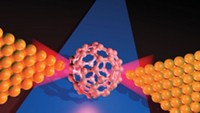Advertisement
Grab your lab coat. Let's get started
Welcome!
Welcome!
Create an account below to get 6 C&EN articles per month, receive newsletters and more - all free.
It seems this is your first time logging in online. Please enter the following information to continue.
As an ACS member you automatically get access to this site. All we need is few more details to create your reading experience.
Not you? Sign in with a different account.
Not you? Sign in with a different account.
ERROR 1
ERROR 1
ERROR 2
ERROR 2
ERROR 2
ERROR 2
ERROR 2
Password and Confirm password must match.
If you have an ACS member number, please enter it here so we can link this account to your membership. (optional)
ERROR 2
ACS values your privacy. By submitting your information, you are gaining access to C&EN and subscribing to our weekly newsletter. We use the information you provide to make your reading experience better, and we will never sell your data to third party members.
Analytical Chemistry
X-Rays Discern Crystal Enantiomers
June 16, 2008
| A version of this story appeared in
Volume 86, Issue 24
Conventional X-ray crystallography can identify structures of enantiomers, but it can't distinguish between right- and left-handed crystals. Now, a group led by Yoshikazu Tanaka of the Japanese research institute RIKEN has used circularly polarized synchrotron X-ray beams to elucidate the handedness of crystals (Phys. Rev. Lett. 2008, 100, 145502). Other techniques to identify crystal chirality typically require either having the crystal interact with another chiral material or slicing or mounting a crystal to view it in a microscope. The researchers used the polarized X-ray technique, called resonant Bragg diffraction, to study two enantiomers of quartz and found that the two crystal types reflect different X-ray intensities depending on right- or left-circular polarization. The approach could be a useful screening tool for applications that require a chiral environment such as biomolecular interactions or selective reflection by liquid crystals in optical applications. "While this synchrotron-based technique may not have many immediate practical applications, Tanaka and coworkers have demonstrated a new and supremely elegant process for characterizing chiral materials," says research scientist Robert M. Hazen of Carnegie Institution for Science, Washington, D.C.




Join the conversation
Contact the reporter
Submit a Letter to the Editor for publication
Engage with us on Twitter